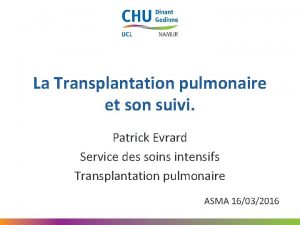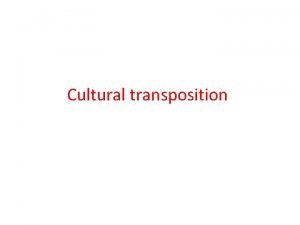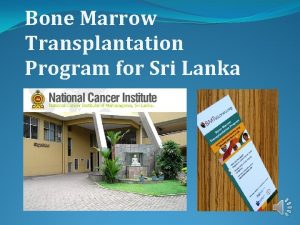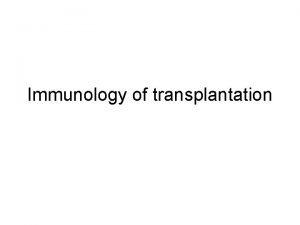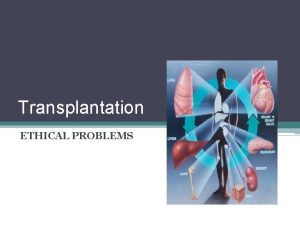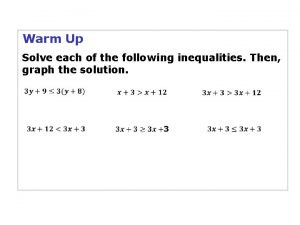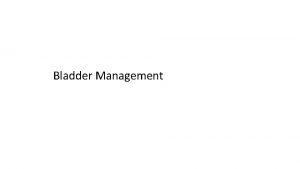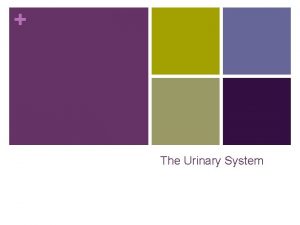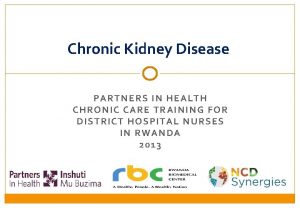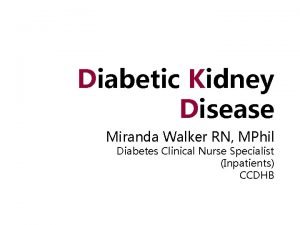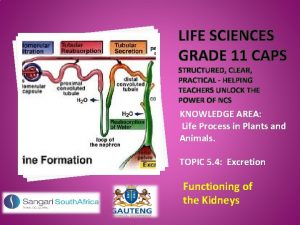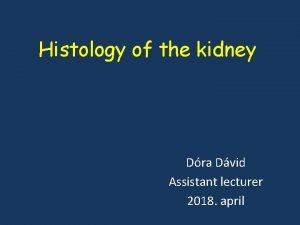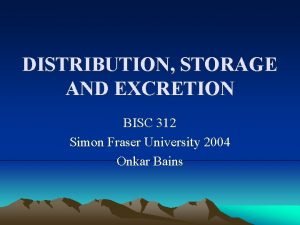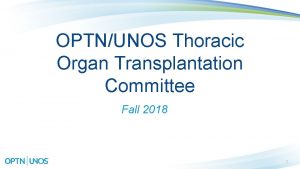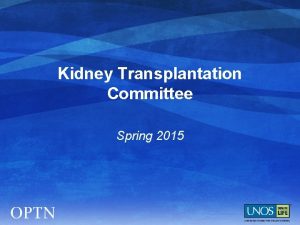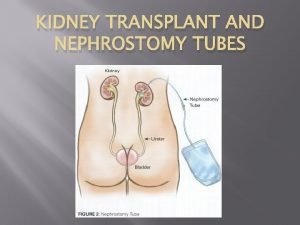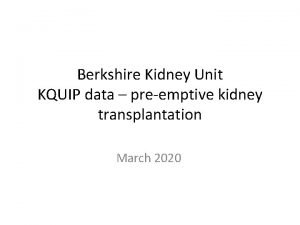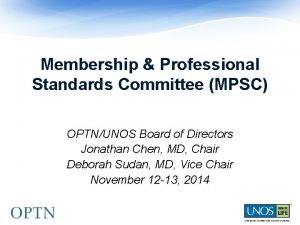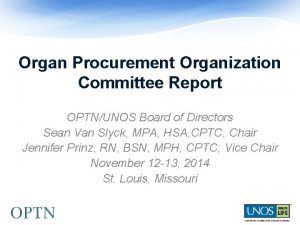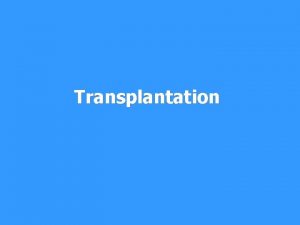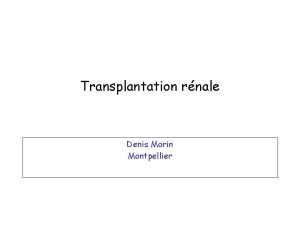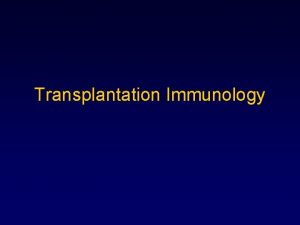OPTNUNOS Kidney Transplantation Committee Fall 2017 1 Kidney


















- Slides: 18

OPTN/UNOS Kidney Transplantation Committee Fall 2017 1

Kidney Committee Update § SLK § 2 Allocation Policy Implementation Year KAS Data § Allowing Deceased Donor-Initiated KPD Chains Concept Paper § Improving Allocation of En Bloc Kidneys (Voting item) § Improving Allocation of Dual Kidneys (Voting item) 2

Implementation Update SLK Allocation • Primary Changes: SLK medical eligibility criteria, SLK allocation requirements, safety net for liver recipients registered on kidney waiting list within a year after liver transplant (effective Aug. 10). • New Waitlist fields available since May 31. • Visit https: //optn. transplant. hrsa. gov/learn/professional-education/ for policy and system training resources. 3

Implementation Update New Waitlist Reports determine candidate eligibility at their center: § “Kidney Priority for Liver Transplant Recipient” report § “Liver-Kidney (SLK) Candidate” report 4

The Kidney Allocation System (KAS) The First Two Years Prepared for OPTN Kidney Transplantation Committee April 19, 2017 Amber R. Wilk, Ph. D John Beck Anna Y. Kucheryavaya, MS United Network for Organ Sharing UNOS Research Department

Background Performance initially tracked monthly through June 2015 (“out of the gate” reports) ● Six month report completed September 2015 ● One year report completed April 2016 ● ● Two year analysis completed April 2017 ● Post-KAS years only, comparing Post-KAS Year 1 to Post-KAS Year 2: ● Post-KAS Year 1: December 4, 2014 - December 3, 2015 ● Post-KAS Year 2: December 4, 2015 - December 3, 2016 ● Pre-KAS: December 4, 2013 – December 3, 2014 6

Geographic Distribution of Kidney Transplants Post−KAS Year 1 Post−KAS Year 2 25% 20% 17. 5% 18. 0% 14. 2% 13. 0% 13. 5% 12. 7% 10. 9% 9. 7% 10. 2% 9. 9% 7. 4% 6. 4% 5% 3. 9% 3. 4% 3. 8% 6. 4% 6. 3% 7. 2% 6. 7% 7. 8% 7. 2% 3. 7% 0% 1 2 3 4 5 6 7 8 9 10 11 OPTN Region No substantial changes in any region post−KAS Year 2 vs. post−KAS Year 1. 7

Deceased Donor Transplants by Recipient Age Waitlist (11/30/2016) Post−KAS Year 1 Post−KAS Year 2 43. 6% 40% 38. 8% 37. 2% 30% 27. 9% 26. 0% 24. 4% 22. 4% 19. 5% 20% 18. 2% 12. 8% 10% 12. 0% 8. 6% 2. 3% 0. 2% 0. 7% 0. 2% 0. 8% 0. 7% 2. 3% 0. 5% 0% 0− 5 6− 10 11− 17 18− 34 35− 49 50− 64 65+ Recipient Age The percent of transplants to younger candidates (18− 49) decreased slightly, and transplants to 50+ candidates increased slightly. 8

Geographic Distribution of Pediatric Kidney Transplants Pre−KAS Post−KAS Year 1 Post−KAS Year 2 50% 40% 30% 21. 2% 20% 16. 8% 15. 8% 16. 7% 14. 7% 15. 0% 16. 0% 15. 6% 13. 2% 10. 0% 9. 9% 9. 8% 10% 7. 6% 5. 9% 4. 1% 5. 6% 2. 9% 2. 2% 9. 5% 7. 6% 7. 7% 7. 1% 7. 7% 7. 4% 6. 5% 6. 1% 5. 2% 5. 0% 3. 4% 3. 9% 0% 1 2 3 4 5 6 7 8 9 10 11 OPTN Region Post−KAS, most regions had higher or similar percent of pediatric transplants Year 2 vs. Year 1; regions 7, 10, and 11 had a decrease in pediatric transplants, while regions 1 and 8 saw increases. 9

CPRA 99 -100% Recipient “Bolus Effect” 20 15. 7% 15. 4% 15 14. 6% 13. 4% 12. 6% 10 12. 2% 11. 7% KAS Implementation Percent of Transplants to CPRA 99− 100% Recipients 17. 7% 12. 4% 11. 8% 12. 3% 11. 9% 11. 2% 10. 6% 10. 1% 9. 7% 9. 5% 9. 9% 9. 6% 10. 5% 10. 0% 9. 7% 10. 1% 9. 6% 5 3. 5% 3. 2% 2. 9% 2. 3% 1. 8% 2. 0% 1. 6% 2. 9% 2. 5% 2. 8% 2. 4% 1. 8% 0 Feb− 2014 May− 2014 Aug− 2014 Nov− 2014 Feb− 2015 May− 2015 Aug− 2015 Nov− 2015 Feb− 2016 May− 2016 Aug− 2016 Nov− 2016 Feb− 2017 Transplant Date Transplants to CPRA 99− 100% patients rose sharply after KAS but have tapered to around 10%. 10

20 18. 6% 17. 1% 15 KAS Implementation Percent of Transplants to Recipients with 10+ Years of Dialysis High Dialysis Time Recipient “Bolus Effect” 10 12. 4% 12. 2% 11. 1% 9. 1% 8. 9% 8. 3% 7. 7% 7. 6% 7. 5% 6. 7% 6. 2% 6. 0% 7. 2% 7. 0% 6. 8% 6. 7% 6. 2% 5. 7% 6. 0% 5. 7% 5. 6% 5. 2% 5 4. 3% 4. 8% 4. 6% 4. 5% 4. 1% 3. 3% 3. 6% 0 Feb− 2014 May− 2014 Aug− 2014 Nov− 2014 Feb− 2015 May− 2015 Aug− 2015 Nov− 2015 Feb− 2016 May− 2016 Aug− 2016 Nov− 2016 Feb− 2017 Transplant Date 11 Transplants to candidates with 10+ years of dialysis rose sharply after KAS but have tapered substantially to around 6%.

Kidney Discard Rate by KDPI KAS Year Pre−KAS Post−KAS Year 1 Post−KAS Year 2 60% 54. 8% 58. 9% 59. 3% 40% 20% 17. 1% 2. 5% 6. 7% 6. 4% 2. 7% 2. 5% 18. 5% 19. 7% 5. 2% 0% 0− 20 21− 34 35− 85 86− 100 66. 8% 65. 0% 60% 40. 2% 41. 7% 40% 28. 4% 20% 0% 1. 3% 1. 7% 0− 10 3. 6% 3. 7% 11− 20 6. 1% 4. 7% 21− 30 6. 9% 7. 8% 31− 40 10. 1% 11. 8% 41− 50 14. 3% 16. 2% 51− 60 19. 8% 61− 70 71− 80 81− 90 91− 100 KDPI (%) The overall discard rate increased from 19. 3% post−KAS Year 1 to 19. 9% post−KAS Year 2. KDPI 21− 34% kidneys saw a decrease in discard rate in the most recent year, while KDPI 35− 85% kidneys discard rates increased again. KDPI 0− 20% and 86− 100% remain fairly stable in the post−KAS era. 40

Delayed Graft Function (DGF) Rates 29. 6% 30% 27. 7% Percent Delayed Graft Function (DGF) 24. 4% 20% 10% 0% Pre−KAS Post−KAS Year 1 Post−KAS Year 2 KAS Year The percentage of recipients requiring dialysis within the first week after transplant decreased from 29. 6% post−KAS Year 1 to 27. 7% post−KAS Year 2, but remains higher than pre−KAS. The decrease was significant (p = 0. 0010). 13

Patient and Graft Survival - Overall KAS Year Pre−KAS 100% 95% Graft Survival (%) 95% Patient Survival (%) Post−KAS p−value: 0. 0026 90% 85% 80% 0 30 60 90 120 150 180 210 240 Time Post−Transplant (Days) 270 300 330 360 p−value: 0. 0727 90% 0 30 60 90 120 150 180 210 240 Time Post−Transplant (Days) 270 300 330 360

Highlights: First 2 years of KAS ● Many very highly sensitized and high dialysis time patients have been transplanted under KAS ● Transplants to these groups have tapered over 2 years ● Deceased donor transplant volume has increased ● Largest impact on pediatric transplants is still concentrated in Region 5 ● However, utilization of recovered kidneys has not improved ● DGF has increased but is slowly trending downward ● Post-KAS, 1 -year graft (94. 1%) and recipient (96. 2%) survival are excellent, though slightly lower than pre-KAS 11

New Project Allowing Deceased Donor-Initiated KPD Chains • Concept Paper with three models for allowing deceased donors to initiate KPD chains • Requesting feedback on proposed methods and feasibility • Available for comment on OPTN website 16

Concepts Under Consideration Candidate. Driven Model • FIRST: Candidate receives increased priority on Waitlist • THEN: Candidate is transplanted • THEN: Paired living donor donates List Exchange Chains Model • FIRST: Paired living donor donates • THEN: Paired candidate receives priority on Waitlist Donor-Driven Model • FIRST: Deceased donor organ redirected from Waitlist allocation to a specific KPD program and their matching priorities • THEN: KPD Candidate matched and transplanted • THEN: Paired living donor donates 17

Questions? Nicole Turgeon, MD Kidney Committee Chair nturgeo@emory. edu Amber Wilk, Ph. D Kidney Committee Research Liaison amber. wilk@unos. org Chelsea Rock Haynes, MPA Kidney Committee Liaison chelsea. haynes@unos. org Gena Boyle, MPA SLK Liaison gena. boyle@unos. org 18
 Patrick evrard transplantation
Patrick evrard transplantation Cultural transposition
Cultural transposition Bone marrow transplantation sri lanka
Bone marrow transplantation sri lanka How does a kidney transplant work
How does a kidney transplant work Law of transplantation
Law of transplantation Stem cell phuket
Stem cell phuket Inequalities warm up
Inequalities warm up Njdv
Njdv Renal pelvis
Renal pelvis Layers of kidney
Layers of kidney Slk medical abbreviation transplant
Slk medical abbreviation transplant Kidney
Kidney Symptomatic polycystic kidney disease
Symptomatic polycystic kidney disease 7 functions of the kidney
7 functions of the kidney Life science grade 11 kidney practical
Life science grade 11 kidney practical Corpusculum renale
Corpusculum renale Two kidneys
Two kidneys Kidney
Kidney What is a renal lobule
What is a renal lobule
